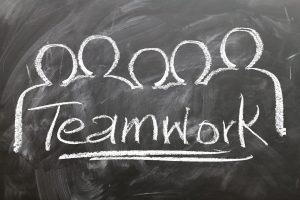Leaders,
What sets high-performing teams consistently apart from the rest? Is there a  special ingredient that makes them click? And more importantly: how can leaders at all levels foster and accelerate this kind of team excellence? The truth is: extraordinary teams are built, not born. And yes, there is a method to the magic. Let’s dive into what makes these teams special, and how you can foster their success.
special ingredient that makes them click? And more importantly: how can leaders at all levels foster and accelerate this kind of team excellence? The truth is: extraordinary teams are built, not born. And yes, there is a method to the magic. Let’s dive into what makes these teams special, and how you can foster their success.
According to Jon Katzenbach and Douglas Smith in „The Wisdom of Teams“, high-performing teams aren’t just well-oiled machines; they are driven by a deeper sense of purpose and a shared accountability that fuels results.
They:
- Set ambitious and meaningful goals
- Work with efficiency, mutual respect, and commitment
- Combine complementary skills, often interchangeable
- Rely on managers who lead by example
- Are deeply customer-oriented.
These traits alone, though, don’t create magic. The real difference? Passion and ownership. These teams believe in their mission. They want to win together. They solve problems quickly, thrive in complexity, and keep getting better.
Great teams need great leaders (not in the superhero sense). High-impact leaders make smart, consistent investments upfront:
- They define a clear mission
- They gain emotional buy-in from team members
- They design smart action plans
- They have honest, action-focused conversations
- And, crucially, they model the behavior they want to see.
Standout leaders tend to answer three key questions with conviction:
- Who are we? (Purpose and values)
- What do we do? (Clarity of mission and goals)
- How do we act? (Processes and behaviors that support the “Who” and “What”)
John Kotter, in „Leading Change“, affirms that teams built on trust, respect, and learning adapt better, especially during organizational change. A resilient team isn’t just a bonus, it’s a necessity.
If your team is stuck or spinning its wheels, it might be time to go back to basics. Richard Beckhard’s GRPI model offers a diagnostic lens for what makes teams click or stall.
GRPI stands for:
- Goals: Clear purpose, priorities, and expected outcomes
- Roles: Who does what, and why
- Processes: Decision-making, workflows, communication
- Interpersonal Relationships: Trust, flexibility, feedback, conflict resolution.
Teams that align on GRPI are not just aligned, they are unstoppable.
Patrick Lencioni, in „The Four Obsessions of an Extraordinary Executive“, offers a simple and powerful playbook:
- Build a cohesive leadership team
→ Trust, accountability, commitment, and productive conflict - Create organizational clarity
→ Clear purpose, values, priorities, and roles - Over-communicate clarity
→ Repeat, simplify, and cascade - Reinforce clarity through human systems
→ Hiring, performance reviews, rewards, even exits
These are not just management tactics, they are habits of culture.
Want to know what holds teams back? Patrick Lencioni outlines the five dysfunctions that quietly kill performance:
- Absence of trust: no vulnerability = no real collaboration
- Fear of conflict: fake harmony stifles growth
- Lack of commitment: no buy-in, no follow-through
- Avoidance of accountability: everyone lets things slide
- Inattention to results: individual goals beat team success.
Here’s a trap leaders fall into far too often: treating symptoms like poor communication or meeting overload, without addressing the real issue.
Want real change? Start with these two fundamental questions:
- Is there a shared, compelling goal?
If not, collaboration won’t happen; why should it? - Is there true interdependence?
If team members don’t rely on each other to succeed, it’s not a team; it’s a group.
Only when these foundations are in place can roles, rules, and processes deliver real impact. Otherwise, you’re decorating the house without pouring the foundation.
Teambuilding isn’t a magic wand. It’s a tool. And like any tool, it must be used wisely:
- Do not use teambuilding to fix leadership problems. If you have a leadership issue, address the leader. Don’t expect an offsite to solve it.
- Do use teambuilding to align around a shared purpose, build trust, and clarify roles; after you’ve addressed the fundamentals.
- And always clarify: what are we trying to achieve? Why can’t this happen through regular leadership? How will we know it worked?
The truth is, there’s no secret, just focused, consistent leadership. Leaders who:
- Set the tone
- Cultivate clarity and trust
- Foster emotional and operational alignment
- Know when to coach and when to challenge.
And above all: leaders who do their inner work – managing ego, staying optimistic, and choosing action over blame. Healthy teams don’t just click; they’re designed, nurtured, and led with intent.
Let’s talk! If you’re ready to grow a healthy, high-performing team or become the kind of leader who builds one – I’m here to help. Through coaching, reflection, and practical tools like GRPI and the Four Disciplines, we will find your leverage points. It starts with clarity and a conversation. Contact me. Let’s make the magic happen.
Further articles on developing teams from this website:
What the best leaders need to know about teams: Safety first!
Hit the spot developing your team
The unique dynamics of senior leadership teams
